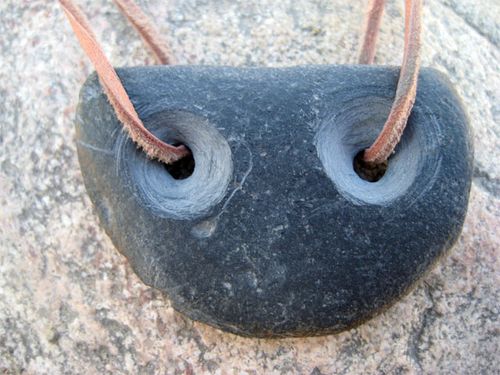Four large groups of Finnish school children were descending on the Kierikki Stone Age Center and both the Director and the Curator were away. I agreed to help out in the Stone Age Village for a second day.
 Looks good, doesn't it? It really makes you feel like you've become a fox
Looks good, doesn't it? It really makes you feel like you've become a fox
As each group came, I demonstrated how to make slate beads while one of the other guides translated. Then we turned them loose to make beads. It was fun.
 A stone pendant
A stone pendant
 Grinding away on their slate beads
Grinding away on their slate beads
 I showed them how to make stone beads, and now they are making them
I showed them how to make stone beads, and now they are making them
After the school groups left I had time to visit "the Thing” to see how the geological investigations were going.
Remember from my May 11 post that "the Thing” appears to be a doughnut- shaped ring of earth about the size of half a soccer field on the south side of the Iijoki River. Riding in the van to the Thing with Professor **Andre Costopoulos** of McGill University, I learned a lot:
The Thing is similar to a category of sites in this part of Finland called "Giant's Churches." Giant's Churches are often oval-shaped like the Thing, but they are made of piled stones, not earth,
It must have had some public and/or ceremonial function,
It is the same age as Stonehenge and similar megalithic monuments in Western Europe,
Stonehenge and other megaliths in Britian and France were made by people who grew crops like wheat and barley. The conventional wisdom that you learn in history classes has always been that hunter-gatherers don't engage in communal construction projects on this scale. They don't have enough food stored to feed the workers.
 This soil shows all kinds of human alteration. Natural soil would have only ONE layer of each color: black on top, then white, then reddish brown. So may alternating layers means that people were moving dirt around.
This soil shows all kinds of human alteration. Natural soil would have only ONE layer of each color: black on top, then white, then reddish brown. So may alternating layers means that people were moving dirt around.
I realized that these people can best be compared to the native tribes of coastal Alaska and British Columbia: nations like the Tlingit, Haida, and Kwakiutl. "Maritime-adapted sedentary hunter-gatherers” said Professor Costopoulos.
 The big black lens of soil in the middle is loaded with organic (carbon-containing) material. That is why it is black. Perhaps people stored food underground here. This feature was exposed this year by local people excavating sand for a road, and now it is in danger of eroding away.
The big black lens of soil in the middle is loaded with organic (carbon-containing) material. That is why it is black. Perhaps people stored food underground here. This feature was exposed this year by local people excavating sand for a road, and now it is in danger of eroding away.
What he means is that because of really abundant seafood like salmon and seals, these people were able, like the Tlingit, Haida and Kwakiutl, to congregate in fairly large villages, stay put for a long time, and build big structures. Many hunter-gatherers in other parts of the world had to wander the landscape in small groups.
There’s a meeting at the lab tonight, so I have to go.

